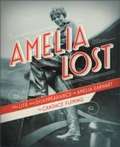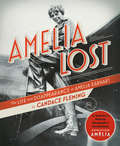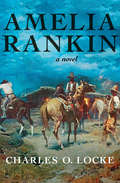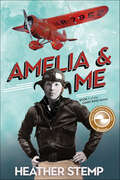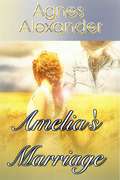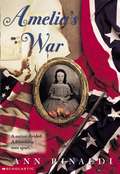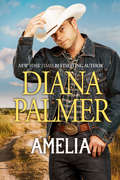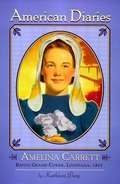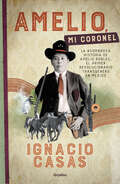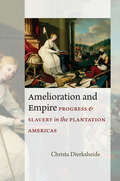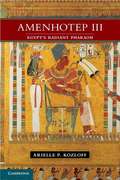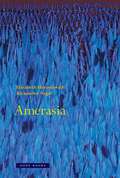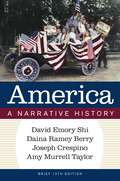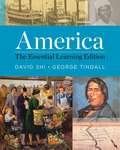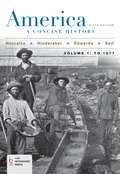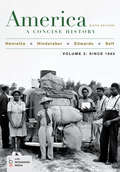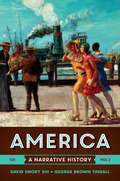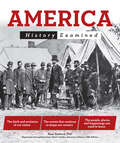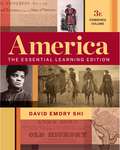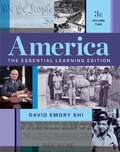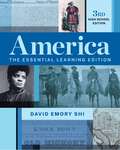- Table View
- List View
Amelia Lost: The Life and Disappearance of Amelia Earhart
by Candace FlemingFrom the acclaimed author of The Great and Only Barnum - as well as The Lincolns, Our Eleanor, and Ben Franklin's Almanac - comes the thrilling story of America's most celebrated flyer, Amelia Earhart. In alternating chapters, Fleming deftly moves readers back and forth between Amelia's life (from childhood up until her last flight) and the exhaustive search for her and her missing plane. With incredible photos, maps, and handwritten notes from Amelia herself-plus informative sidebars tackling everything from the history of flight to what Amelia liked to eat while flying (tomato soup) - this unique nonfiction title is tailor-made for middle graders.
Amelia Lost: The Life and Disappearance of Amelia Earhart
by Candace FlemingFrom the acclaimed author of The Great and Only Barnum--as well as The Lincolns, Our Eleanor, and Ben Franklin's Almanac--comes the thrilling story of America's most celebrated flyer, Amelia Earhart. <P><P>In alternating chapters, Fleming deftly moves readers back and forth between Amelia's life (from childhood up until her last flight) and the exhaustive search for her and her missing plane. With incredible photos, maps, and handwritten notes from Amelia herself--plus informative sidebars tackling everything from the history of flight to what Amelia liked to eat while flying (tomato soup)--this unique nonfiction title is tailor-made for middle graders. <P><P>Amelia Lost received four starred reviews and Best Book of the Year accolades from School Library Journal, Kirkus Reviews, Horn Book Magazine, the Washington Post, and the New York Times.From the Hardcover edition.
Amelia Rankin: A Novel
by Charles O. LockeFrom the acclaimed author of The Hell Bent Kid: The story of a brave woman fighting to protect her land in the midst of a deadly range war Amelia Rankin owns nearly two hundred thousand acres of Texas rangeland. When her husband died, she inherited the vast holdings--and with them, a world of trouble. When Amelia decides to fence off a portion of her land and allow farmers to tend it, she raises the ire of a powerful cattleman who would rather shed blood than see west Texas taken over by homesteaders. The men who work for Amelia vow to stand by her, but when tensions run this high, one spark of violence could set the whole prairie ablaze. Before she knows it, Amelia and her allies are fighting a battle whose outcome will determine the future of the Southwest. From master storyteller Charles O. Locke, Amelia Rankin is an unforgettable tale of passion, violence, and pride.
Amelia and Me
by Heather StempAfter reading about Amelia Earhart in her cousin’s scrapbook, twelve-year-old Ginny Ross decides to become a pilot. It’s 1932 and luckily, the airstrip in her hometown of Harbour Grace, Newfoundland, is a popular launching point for intrepid aviators setting out on transatlantic flights. But how will Ginny’s dream take flight when her mother—and society in general—so fiercely believes a woman’s place is in the home? At the height of the Great Depression, the Ross family certainly can’t spare any money for flying lessons, and Ginny will need a mentor if she is ever going to make it out of Harbour Grace. With the support of her beloved Papa, kind Uncle Harry, and resourceful Aunt Rose, Ginny takes matters into her own hands. When Amelia Earhart herself shows up in Harbour Grace for her first solo flight across the Atlantic Ocean, Ginny notices the townspeoples’ looks of disbelief are slowly turning to looks of admiration and respect. Maybe they will begin to accept Ginny's dream, and maybe Amelia Earhart is the woman to help convince them. Based on the real girlhood of author Heather Stemp’s Aunt Ginny, Amelia and Me is a big-hearted story of determination, grit, and adventure. Readers will love the archival photos of Amelia Earhart and her plane, along with the interesting historical details skillfully weaved throughout the book.
Amelia and the Outlaw
by Lorraine HeathAMELIA With a strict, eagle-eyed judge for a father and two older brothers to back him up, Amelia Harper is doted upon and protected within an inch of her life. She's not even allowed to have a sweetheart until she's seventeen, for example. Amelia longs for the day she can do as she pleases, but that day doesn't seem to be in any hurry to arrive. THE OUTLAW For a young fellow, Jesse Lawton has a surprisingly shady background. The only wonder is that it took him until the age of fourteen to end up in jail, so wild was the path he'd been on. But five years have passed, and his luck finally seems to have turned: he's been freed. If only he can stay on the straight and narrow ... When Jesse arrives at the Harper ranch to work off the remainder of his sentence, it's no surprise that the judge's pretty daughter catches his eye. What he doesn't know is that this young lady is itching for excitement, and with one look into his haunted eyes, Amelia knows she's found it in Jesse. Without meaning to, Amelia forces the erstwhile outlaw into a choice between his freedom and his heart.
Amelia's Marriage
by Agnes AlexanderRafe Donahue, one of the richest ranchers in Wyoming is determined his willful daughter Amelia will marry his foreman, Vince Callahan. Amelia doesn't trust the leering Vince and believes he's out to get the Double D ranch through her. With a mind to thwart her father's plans, Amelia travels to Settlers Ridge to buya husband - for $5000. Half-breed Jed Wainwright si a rough-around-the-edges bounty hunter with a questionable reputation. After his next capture, he's looking to get out of the business and take up ranching. A pretty little blonde shows up at his hotel room door and makes a crazy offer...
Amelia's Revolution
by Kim FlowersIn this alternate version of history, Amelia and her father, the governor of Delaware, attend a formal dinner at the capitol building with several other local leaders to meet with a delegate for Queen Victoria. The delegate declares the United States must sign a treaty with Britain to reinstate colonial rule, or else there will be war. Amelia runs away to warn the rest of the town, but not before she sees the most beautiful girl on earth. To Amelia's horror, the beautiful girl is one of the British delegate's slaves.Slavery had been abolished in the U.S. two generations ago, after the American Revolution. Automatons do the manual labor now, and all of the melting-pot cultures in the nation live in harmony. But in Britain there are still slaves, and gender-queer people are persecuted. Amelia knows she can't allow any treaty with Britain to be signed. She sneaks to the harbor of their coastal capital city and discovers not only the delegate's ship, but an armada on the horizon. She also sees the beautiful girl from before . . . and learns her name is Nadine.Amelia, her best friend Two-Spirit, and Nadine must organize a rebellion involving slaves, Lenni-Lenape warriors, automatons, and a mechanical horse cavalry. Will they be able to stop the British Imperial Navy? And will Amelia win Nadine's heart if she can help her become free?NOTE: The story is continued in the collection, Revolt of the Perfectly Free.
Amelia's War
by Ann RinaldiAs the Civil War rages, Amelia's Maryland town is beset by divisions. Even she and her best friend Josh disagree. Amelia vows not to take sides, until the Confederate troops march into town... led by Josh's uncle.
Amelia: A Novel
by Diana PalmerA historical romance of West Texas from the New York Times–bestselling author. Amelia Howard cherishes her desert country. The dazzling colors, white heat, and rough sensuality of west Texas stir her very soul. But there&’s a serpent in her paradise: King Culhane. A towering sunburned cowboy with silver eyes that miss nothing, he&’s a man she&’s come to despise—no matter how much she had worshiped him when she was younger. As her father pushes her to secure a marriage proposal from King&’s mild-mannered brother in order to marry into the Culhane dynasty, Amelia assumes the mask of a demure young lady, always correct and obedient. It&’s a posture that King holds in contempt. Yet when she reveals the true force of her feelings, she unleashes a smoldering passion that cannot be denied. And everything—propriety, filial duty, even love—will be scorched in the wake of such all-consuming desire.
Amelina Carrett: Bayou Grand Coeur, Louisiana, 1870 (American Diaries)
by Kathleen DueyBayou Grand Coeur, Louisiana, 1863. I wonder if the Confederates think of this war as their own? Or the Yankees? Who would want a war to be their own? Amelina is frightened. She is used to being alone while her Nonc Alain is away trading, but now Yankee soldiers are so close that she can sometimes hear the rumble of gunfire. Just because her close-knit Cajun community has for the most part been uninvolved in the war doesn't mean Nonc Alain's farm would be spared if the Yankees swept through the area. When Amelina makes a startling discovery that challenges everything she's been told about the Yankees, she is forced to make her own decision about what is right and what is wrong. Can she find the courage to face the danger that her decision brings?
Amelio, mi coronel: La asombrosa historia de Amelio Robles, el primer revolucionario tránsgenero en México
by Ignacio CasasBASADA EN HECHOS REALES, AMELIO, MI CORONEL RESCATA DEL OLVIDO A UNO DE LOS PERSONAJES MÁS APASIONANTES Y SINGULARES DE LA REVOLUCIÓN MEXICANA, QUIEN CON REBELDÍA ROMPIÓ LOS MOLDES DE LA ÉPOCA. UNA NOVELA QUE NOS RECUERDA QUE EL DESTINO SE FORJA, AUNQUE SEA A BALAZOS. A los veintiún años, con enaguas y rebozo, Malaquías Amelia de Jesús se unió al Ejército Libertador del Sur, en compañía de la Casimira, la pistola de su amado y difunto padre, y de ese espíritu voluntarioso que tanto le caracterizó. Fue ahí, en el campo de batalla, entre muertes y desplazamientos, pero también entre amores y victorias, donde encontró la fuerza para gritar su nombre: ¡Ameno! Admirado y respetado por generales, capitanes e incluso por la tropa, Amelio Robles luchó junto a notables revolucionarios: Chon Díaz, Heliodoro Castillo, Adrián Castrejón y, por supuesto, Emiliano Zapata. Ya como coronel, dirigió más de quinientos soldados, luchando contra el enemigo, así como contra aquellos que cuestionaban su identidad. Escrita con maestría y ritmo poético por el ganador del Premio de Novela Histórica Grijalbo-Claustro de Sor Juana 2019, Ignacio Casas, Amelio, mi coronel es una obra repleta de pasajes emocionantes, un homenaje a la vida que uno elige.
Amelioration and Empire: Progress and Slavery in the Plantation Americas (Jeffersonian America)
by Christa DierksheideChrista Dierksheide argues that "enlightened" slaveowners in the British Caribbean and the American South, neither backward reactionaries nor freedom-loving hypocrites, thought of themselves as modern, cosmopolitan men with a powerful alternative vision of progress in the Atlantic world. Instead of radical revolution and liberty, they believed that amelioration--defined by them as gradual progress through the mitigation of social or political evils such as slavery--was the best means of driving the development and expansion of New World societies. Interrogating amelioration as an intellectual concept among slaveowners, Dierksheide uses a transnational approach that focuses on provincial planters rather than metropolitan abolitionists, shedding new light on the practice of slavery in the Anglophone Atlantic world. She argues that amelioration--of slavery and provincial society more generally--was a dominant concept shared by enlightened planters who sought to "improve" slavery toward its abolition, as well as by those who sought to ameliorate the institution in order to expand the system. By illuminating the common ground shared between supposedly anti- and pro-slavery provincials, she provides a powerful alternative to the usual story of liberal progress in the plantation Americas. Amelioration, she demonstrates, went well beyond the master-slave relationship, underpinning Anglo-American imperial expansion throughout the Atlantic world.
Amenhotep III: Egypt's Radiant Pharaoh
by Arielle P. KozloffThis book follows the life story of Amenhotep III, one of the most important rulers of ancient Egypt, from his birth and into the afterlife. Amenhotep III ruled for thirty-eight years, from ca.1391-1353 BC, during the apex of Egypt's international and artistic power. Arielle P. Kozloff situates Amenhotep in his time, chronicling not only his life but also the key political and military events that occurred during his lifetime and reign, as well as the evolution of religious rituals and the cult of the pharaoh. She further examines the art and culture of the court, including its palaces, villas, furnishings and fashions. Through the exploration of abundant evidence from the period, in the form of both textual and material culture, Kozloff richly re-creates all aspects of Egyptian civilization at the height of the Mediterranean Bronze Age.
Amerasia
by Alexander Nagel Elizabeth HorodowichA connected world as imagined by early modern European artists, mapmakers, and writers, where Asia and the Americas were on a continuumAmerica and Asia mingled in the geographical and cultural imagination of Europe for well over a century after 1492. Through an array of texts, maps, objects, and images produced between 1492 and 1700, this compelling and revelatory study immerses the reader in a vision of a world where Mexico really was India, North America was an extension of China, and South America was marked by a variety of biblical and Asian sites. It asks, further: What does it mean that the Amerasian worldview predominated at a time when Europe itself was coming into cultural self-definition? Each of the chapters focuses on a particular artifact, map, image, or book that illuminates aspects of Amerasia from specific European cultural milieus. Amerasia shows how it was possible to inhabit a world where America and Asia were connected either imaginatively when viewed from afar, or in reality when traveling through the newly encountered lands. Readers will learn why early modern maps regularly label Mexico as India, why the “Amazonas” region was named after a race of Asian female warriors, and why artifacts and manuscripts that we now identify as Indian and Chinese are entangled in European collections with what we now label Americana.Elizabeth Horodowich and Alexander Nagel pose a dynamic model of the world and of Europe’s place in it that was eclipsed by the rise of Eurocentric colonialist narratives in the nineteenth and twentieth centuries. To rediscover this history is an essential part of coming to terms with the emergent polyfocal global reality of our own time.
America
by David E. Shi Daina Ramey Berry Joe Crespino Amy Murrell TaylorA best-selling narrative history enters a new generation The beloved and best-selling America: A Narrative History family of books has been used by millions of students because of its enthralling storytelling that brings history to life. Award-winning teachers and scholars Daina Ramey Berry (University of California, Santa Barbara), Joseph Crespino (Emory University), and Amy Murrell Taylor (University of Kentucky) join lead author David Shi (Furman University) to enhance the balanced narrative with a focus on the diverse experiences of women in American history. Seamlessly integrated into the reading experience, new tools help students to read at the college level and engage with the building blocks of history: primary sources. This purchase offers access to the digital ebook only.
America
by George Tindall Erik Anderson Jonathan Lee David ShiLively yet concise, The Essential Learning Edition of America blends Shi and Tindall s unrivalled narrative style with innovative pedagogy to help students understand major historical developments and strengthen critical interpretive skills. Online adaptive learning tools enhance and assess students mastery of the core objectives from the text."
America
by James A. Henretta Rebecca Edwards Robert O. Self Eric HinderakerKnown for its interpretive voice, balanced analysis, and brief-yet-comprehensive narrative, America: A Concise History helps students to make sense of it all while modeling the kind of thinking and writing they need to be successful. Offering more value than other brief books, America is competitively priced to save your students money, and features built-in primary sources and new ways of mastering the content so your students can get the most out of lecture and come to class prepared. The sixth edition rolls out Bedford/St. Martin's new digital history tools, including LearningCurve, an adaptive quizzing engine that garners over a 90% student satisfaction rate, and LaunchPad, the all new interactive e-book and course space that puts high quality easy-to-use assessment at your fingertips. Easy to integrate into your campus LMS, and featuring video, additional primary sources, a wealth of adaptive and summative quizzing, and more, LaunchPad cements student understanding of the text while helping them make progress toward learning outcomes. It's the best content joined up with the best technology.
America
by James A. Henretta Rebecca Edwards Robert O. Self Eric HinderakerKnown for its interpretive voice, balanced analysis, and brief-yet-comprehensive narrative, America: A Concise History helps students to make sense of it all while modeling the kind of thinking and writing they need to be successful. Offering more value than other brief books, America is competitively priced to save your students money, and features built-in primary sources and new ways of mastering the content so your students can get the most out of lecture and come to class prepared.
America A Narrative History (Vol. 2) 10th Edition
by David Emory Shi George Brown TindallThis Tenth Edition of America: A Narrative History seeks to improve upon a textbook grounded in a compelling narrative history of the American experience.
America (History Examined)
by Alan AxelrodDiscover the stories that shaped our nationSure, you know that America's colonists won our independence from Great Britain, that Washington became our first president, and that Lincoln freed the slaves. But these key events merely scratch the surface of our nation's history and the moments that helped shape the United States into the rich, diverse, and complex country it is today.America: History Examined explores the defining moments, decisions and people who have written our country's story up to now, including:The first people of America, with new archaeological and ethnographical findingsAn examination of the origins and course of the American RevolutionThe signing of the Declaration of Independence and creation of our ConstitutionThe rise of Andrew Jackson and parallels with current American Populism A revealing look at the different causes that led to the American Civil WarThe World Wars and how they led to America's emergence as a superpowerA critical examination of the Vietnam War and how it tested American prideGrowing partisan gridlock, globalism vs. nationalism, and the dichotomy between the Obama and Trump presidencies
America (Third Edition) (Vol. Combined Volume): The Essential Learning Edition (combined Volume)
by David E. ShiThe best-selling storytelling approach with more support for student success. David Shi’s rich storytelling style fills America’s celebrated narrative with colorful biographical sketches and vivid first-person quotations. The latest edition welcomes more diverse voices with new coverage of the Latino/a experience as well as on-going enhanced coverage of gender, African American, Native American, immigration, and LGBTQ history. The Essential Learning Edition surrounds these stories with a framework that guides reading and develops the skills required for analyzing primary and secondary sources.
America (Third Edition) (Vol. Volume 1): The Essential Learning Edition (combined Volume)
by David E. ShiThe best-selling storytelling approach with more support for student success. David Shi’s rich storytelling style fills America’s celebrated narrative with colorful biographical sketches and vivid first-person quotations. The latest edition welcomes more diverse voices with new coverage of the Latino/a experience as well as on-going enhanced coverage of gender, African American, Native American, immigration, and LGBTQ history. The Essential Learning Edition surrounds these stories with a framework that guides reading and develops the skills required for analyzing primary and secondary sources. This purchase offers access to the digital ebook only.
America (Third Edition) (Vol. Volume 2): The Essential Learning Edition (combined Volume)
by David E. ShiThe best-selling storytelling approach with more support for student success. David Shi’s rich storytelling style fills America’s celebrated narrative with colorful biographical sketches and vivid first-person quotations. The latest edition welcomes more diverse voices with new coverage of the Latino/a experience as well as on-going enhanced coverage of gender, African American, Native American, immigration, and LGBTQ history. The Essential Learning Edition surrounds these stories with a framework that guides reading and develops the skills required for analyzing primary and secondary sources.
America (Third High School Edition): The Essential Learning Edition (combined Volume)
by David E. ShiA beloved storytelling approach with tools that develop history skills America puts narrative front and center with David Shi’s rich storytelling style. The new editions further reflect the state of our history and society with new coverage of the Latino/a experience, in addition to updated coverage of other groups, including Native Americans, African Americans, and the LGBTQ community in America. America has a focus on student success: providing extra support in and out of class through core learning objectives that are carried throughout the text and resources, the InQuizitive adaptive learning tool, and new digital resources focused on primary and secondary sources. America gives students extra support to effectively engage with the story and build critical history skills. From the engaging narrative through the consistency of the core objectives to the book's design - America lends itself to student engagement and success. This purchase offers access to the digital ebook only.
